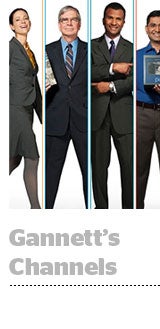 As one of the country’s largest broadcast and newspaper owner, Gannett‘s Q2 results continue to perfectly demonstrate the promise and problems of media in transition: digital dollars are growing at a healthy 20% clip over last year, but it still only supplies 30% of the total revenues. Read the release (PDF).
As one of the country’s largest broadcast and newspaper owner, Gannett‘s Q2 results continue to perfectly demonstrate the promise and problems of media in transition: digital dollars are growing at a healthy 20% clip over last year, but it still only supplies 30% of the total revenues. Read the release (PDF).
As the McLean, Va.-based company continues to build its digital businesses, which include jobs site Careerbuilder, rich media provider PointRoll and the 120 websites associated with its TV stations, local newspapers and national flagship USA Today, the strategy Gannett has been pursuing the past few years is becoming more clear: prepare for the continued rise of online and mobile. But, in the meantime, double down on TV, which is where the real advertising revenue resides – and will continue to, as video bridges the divide between screens.
That ethos was certainly reflected in Gannett CEO Gracia Martore’s opening remarks on the Monday morning Q2 earnings call. (Transcript via Seeking Alpha.)
“We’ve completely redesigned the entire suite of mobile and desktop products to provide better consumer experiences and more higher-value advertising such as video. Our sites and apps will have a more unified look and feel based on the… USA TODAY mobile apps and will have consistent advertising options across properties, with advanced targeting to enable broader ad solutions.”
Here’s a snapshot of Gannett’s Q2:
- Net income dropped 5.2% to $113.6 million, with broadcasting, digital and circulation all growing decently, but not enough to balance out publishing’s falling ad sales. Publishing dollars slipped 1.7% from the same period last year, while broadcasting was up 3.2%.
- Total revenue was flat at $1.3 billion.
- Digital revenues company-wide were $374.3 million, 20.1% higher than last year. Within the publishing segment, digital revenues grew 49.8% year-over-year.
Just over a month ago, Gannett offered $1.5 billion to purchase local broadcast operator Belo as a way to strengthen its TV coverage, which primarily benefits from rising political advertising. Gannett’s stated goal in buying the Dallas-based local TV owner involves creating an advertising and content “SuperGroup,” ultimately serving as the basis for a wider digital sales network, something Gannett had hoped to achieve with its former newspaper paper partners in the defunct quadrantONE joint venture.
Not much was said individually about how Gannett’s smaller digital properties, which include e-circulars provider ShopLocal, daily discount outfit Deal Chicken, mobile rewards program Mobestream Media (Key Ring) and Facebook ad platform Blinq Media, fit into the SuperGroup, but as digital and traditional draw closer together, it’s easy to see how those entities and the broadcast affiliates could dovetail nicely.
Among the hints Martore provided in the call was highlighting some of its new digital offerings.
For example, sports – along with weather – has always been the primary audience and advertising builder for local media. This quarter, Gannett’s Sports Group debuted “For The Win,” which Martore described as a mobile first, social sharing-focused product.
“The launch of what we call FTW was sponsored exclusively and subsequently renewed at a significant CPM and effective annual run rate,” she said. “We are also pleased that since our acquisition of Big League Sports last year and the roll up of all Gannett’s sport assets into the Sports Group, we have maintained a top 5 audience position as measured by comScore as we continue to increase digital audience and scale and revenue opportunities.”
Digital Marketing Services is shaping up another important part of Gannett’s transitional plans. The unit’s existence reflects the industrywide “publisher as marketing agency” trend. The Digital Marketing Services is intended to leverage Gannett’s local brand presence and sales expertise to help develop advertisers’ strategies outside of the usual selling of inventory for its newspapers and TV properties. In Q2, the unit boasted a 90% revenue gain, though that was off of a relatively modest base. True growth won’t be known until next year.
In the meantime, Gannett is also hoping to augment digital advertising with paying digital subscribers. While Martore’s previously stated goal was to have 250,000 to 300,000 paying digital subs by the end of 2013, it reported only 65,000 by the year’s halfway mark.











